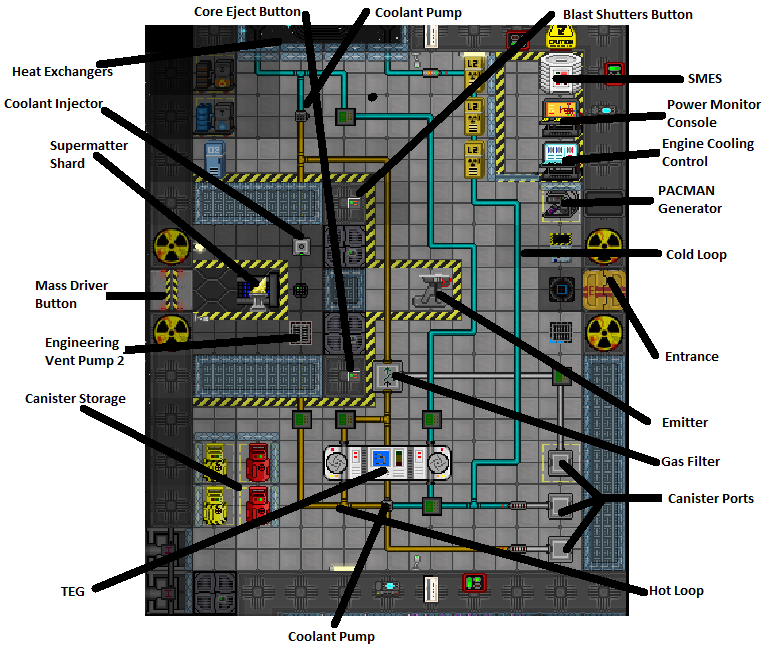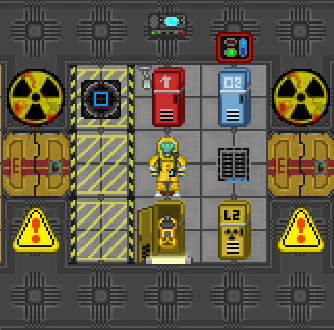Supermatter Engine
Introduction
The Supermatter Engine is not as simple as a Singularity or Tesla engine. It is far more complicated, and it requires regular upkeep and checking to maintain optimum performance. It is also much more adaptable, with many settings and tweakable options to improve, or ruin, your engine.
Supermatter Theory
The supermatter engine produces power via a Thermoelectric Generator, or TEG. This large white device has two inputs for pipes. It generates power based on the difference in temperature between the two inputs. This means that you want the cold side to be very cold, and the hot side to be very hot. The larger the difference, the more power you will make. The cold loop (or blue loop) is fairly simple. It leads up to heat exchanging pipes in space. The gas runs through the pipes and becomes very cold. Then it flows back down into the right (cold) side of the TEG. This requires next to no maintenance and will run on its own. The second loop is the hot loop, also known as the yellow loop. This is where things get complicated. The yellow loop runs to the top of the room, and enters into the reactor core. The reactor contains the Supermatter Shard (the yellow crystal thing). It is EXTREMELY IMPORTANT that you do not interact with the shard in any way, as it is both highly radioactive and will kill you instantly if you touch it. If you are the CE or AI it is a good idea to bolt the hatches leading into the core to prevent any accidents. Now, the Supermatter Shard is aligned with a Emitter. This emitter fires a beam of energy that will hit the supermatter shard and energize it. The beam will also hurt, a lot, so don’t stand in front of it. When the shard is hit by the energy beam, it will produce 3 things: heat, plasma, and pure oxygen. The heat is the important part, because this will heat the gas that flows into the chamber via the Coolant Injector. Don’t be fooled by the name, this is very hot gas. The air will sit in the chamber and be heated by the shard, then be pumped out by Engineering Vent Pump 2 (coders rename these to logical names please). This superheated gas then flows into the hot side of the TEG and repeats the cycle. The TEG should now be generating power. The amount of power is based of the difference in temperature in the hot and cold loop. We will discuss how to maximize this power later in the module.
Setup
The first thing you should do is don a radiation suit and some Meson Scanners. These will allow you to work safely without being irradiated. Side effects of radiation poisoning is hair loss, hallucinations, and death. Next follow these steps to startup the engine.
- Take two of the red nitrogen canisters, and attach them to the two lower connector ports. One supplies gas to the cold loop and the other to the hot loop.
- Take a yellow canister and attach it to the top port. This will hold your waste gasses.
- Walk up to the gas filter above the TEG, and make sure it is set-up to filter O2. If this step is forgotten then the high oxygen concentration will start a fire in the core chamber. You (probably) don’t want that.
- At the top of the room near the radiation lockers are the cold loop Heat Exchange Pipes that run through space. There is a valve here - set it to 450kPa.
- To your right is the blue Engine Cooling Control computer, or ECC. This monitors the reactor chamber and provides lots of useful information. You want to turn on the output regulator. This value will tell Engineering Vent Pump #2 to pump out air until the pressure in the core is equal to that value. Set the value to 100 with the button below.
- Return to the lower part of the room and activate the pumps connected to the canisters. Make sure the pumps at are the maximum pressure, so all of the N2 is moved into the loops. This will drain the canister very quickly. Do not worry, this is normal. You do not need to add more coolant than this.
- Turn on the emitter. HURRAY! You are now generating power!
Maintenance
The supermatter engine is not like the Singularity or Tesla, you have to monitor it. For the most part it will continue running on its own, but throughout the round you can make changes and optimize it to produce more power. Here are some steps to follow when monitoring the core. Verify that there are no fires in the core chamber. If so follow the steps in the emergency section of this guide. Check power output and adjust the valves and pressures as needed. Verify the SMES is sending enough power.
Many of the settings can be tweaked to change performance. You can adjust the gas filter to increase the O2 content in the reactor core. You can adjust the output pump to change the temperature of the gas leaving the chamber. A higher value will let the air stay in the chamber longer, allowing for higher temperatures. Experiment! Most likely you will not mess anything up too bad, as you can revert any issues that might arise if you act quickly enough. �
Emergency Procedures
Things have gone horribly wrong and the crew is shouting at you to fix it. Don’t panic! This guide should help you fix most of your issues.
Core Delamination
Core delamination is caused by overheating. This can be caused by a variety of reasons, and the end result is the same: A big boom. Often times delamination happens without warning and can quickly go from 15% to 40-50% if unattended. These spikes in instability are dangerous and need to be your first priority.
Early Stage
- Shutdown Emitter.
- Check for obvious causes (core on fire, etc).
- Disable the injector at the ECC.
- Wait for the temperature to decrease and the warnings to disappear.
Mid Stage
- Follow all previous steps.
- Set the Output Regulator value to zero at the ECC to attempt to remove all the gas from the core.
- Advise CoC of possible Engine Emergency.
- Perform a SCRAM (instructions below) if CoC requests.
Late Stage
- Follow all previous steps.
- Inform COC of Engine Emergency.
- Engage both coolant pumps to attempt to equalize the temperature.
- Attempt to cool core manually with fire extinguishers (dangerous).
- If these are ineffective eject the core to prevent catastrophic explosion.
Core Fire
A Core Fire is when the gases in the chamber ignite and start a fire. 99% of the time this is caused by having a too high oxygen percentage in your core. Generally at normal operating temperatures fires will start at 12% oxygen or higher. At higher temperatures though it can start at lower concentrations.
The root cause is normally someone forgetting to activate the gas filter, and it can be fixed by turning it on/maximizing the pressure. Be warned, a fire can quickly lead to Core Delamination, so do not ignore it.
Core Leak
Oh look, nobody bolted the maintenance doors to the core chamber, and somehow somebody opened it. Now all your gas is leaking out and it is pushing you away from the door so you cannot close it. Simply run to the shutters button to close the blast shutters. Then have a buddy stand next to the open door and quickly close it when you raise the shutters. You will have lost lots of N2, and most likely irradiated the compartment. Adding more N2 is easy, but make sure people know not to walk into the compartment without radiation suits.
Emergency Gas Shunt/SCRAM
You have royally screwed things up now, and you need to quickly shutdown the reactor and prevent a meltdown, but save the Shard. You will be severely injured (and possibly die) from doing this. However this might be the only way to stop a catastrophic core fire if it grows too large.
- Turn off the emitter.
- Disable Input Injection, set Output Regulator to zero, and enable both coolant pumps.
- Run inside the chamber and pull the shard off of the mass driver.
- Run back outside the chamber and hit the mass driver button to open the blast door. This will vent the gas very quickly but you will lose all of it to space.
- Pray.
Cold Start
If you have run out of electrical power, you cannot turn on the emitter to activate the Shard. In order to restore power to the ship you have to cold start the engine. The first thing to try is to fire up the Pacman Generator if it is available. This will supply enough power to activate the emitter.
If the Pacman is unavailable or out of fuel, you will have to be more, creative. Firing laser guns or other energy weapons into it will slightly charge the shard. Also, throwing random stuff into the shard will disintegrate them and create small amounts of power. Throwing clowns into it also works; their sacrifice will not be in vain.
Battle Damage
(With upcoming changes to power distribution this section may be made obsolete.) It is highly recommended that you safely shutdown the reactor while in battle. Turn off the emitter, disable coolant injection, and set the output regulator to zero. Then disable the pumps and filters in both loops. This means that if battle damage is taken and a pipe is destroyed, you are not pumping all your gas into space. Also, closing the blast shutters is advised because the windows may be broken by incoming fire. After the battle is over report the damages (if any) to the chain of command and advise them on repair times. If the repairs will take too long, activate the Pacman generator to supplement the power supply. Repairing the engine should be top priority.
REMEMBER! The CoC needs to be made aware of ALL incidents or accidents that occur. Report through the Chain of Command, first in the engineering channel (:h or :e) to report to your Chief Engineer, who will then report to the Captain via the command channel (:c).�
Modifications
Possibly the best thing about the Supermatter Engine is how modifiable it is. As you work with it you might see some flaws in the design or pump settings. Here are a couple of suggestions for your engine! Be sure to consult the CE when making any modifications, as the engine downtime could affect ship performance. For experienced engineers only.
Easy
There is a filter to remove the waste O2, but you cannot remove the excess plasma. Is there a way to harvest it?
Gas heaters and coolers might allow you to achieve hotter and colder temperatures.
A second emitter might have some interesting effects.
Volume pumps will drastically change the way the pipes move air. You will achieve much higher pressures, but you will have less control.
Medium
Theoretically, you can boost your power output by starting a fire in the core. “Supercharging” the engine with pure O2 might be a way to do this.
Nitrogen has the second highest heat absorption value, paired with its safeness makes it an excellent coolant. Plasma has the highest heat absorption in the game. Could it be the superior coolant?
You could easily get rid of the waste O2 if you sucked it from the core into space.
Hard
Double TEGs? Double Power?
Atmospherics is located directly below the engine room. Could you tie those pipes into the gas loops?
The heat exchanger in space could be expanded into the CE office for extra cooling, don’t expect him to be happy though.


